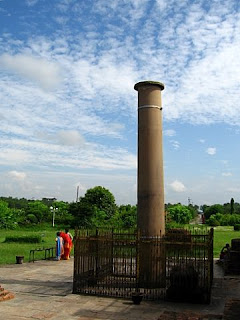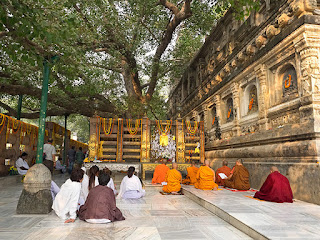1. Lumbini, the Birthplace of the Lord Buddha
Siddhartha Gautama, the Lord Buddha, was born in 623 B.C. in the famous gardens of Lumbini,( Rupandehi District, Western Terai .Nepal.) which soon became a place of pilgrimage. Among the pilgrims was the Indian emperor Ashoka, who erected one of his commemorative pillars there. The site is now being developed as a Buddhist pilgrimage center, where the archaeological remains associated with the birth of the Lord Buddha form a central feature.
2.Bodh Gaya is a religious site and place of pilgrimage associated with the Mahabodhi Temple Complex in Gaya district in the Indian state of Bihar.
It is famous as it is the place where Gautama Buddha is said to have attained Enlightenment (Pali: bodhi) under what became known as the Bodhi Tree. Since antiquity, Bodh Gaya has remained the object of pilgrimage and veneration for both Hindus and Buddhists.For Buddhists, Bodh Gaya is the most important of the main four pilgrimage sites related to the life of Gautama Buddha, the other three being Kushinagar, Lumbini, and Sarnath. In 2002, Mahabodhi Temple, located in Bodh Gaya, became a UNESCO World Heritage Site.
3.Sri Dalada Maligawa or the Temple of the Sacred Tooth Relic is a Buddhist temple in the city of Kandy, Sri Lanka.
The golden-roofed Temple of the Sacred Tooth houses Sri Lanka’s most important Buddhist relic – a tooth of the Buddha. During puja offerings or prayers times, the heavily guarded room housing the tooth is open to devotees and tourists. However, you don’t actually see the tooth. It’s kept in a gold casket shaped like a dagoba (stupa), which contains a series of six dagoba caskets of diminishing size.
4.Adam's Peak is a 2,243 m (7,359 ft) tall conical mountain located in central Sri Lanka. It is well known for the Sri Pada (Sinhala: ශ්රී පාද), i.e., "sacred footprint", a 1.8 m (5 ft 11 in) rock formation near the summit, which in Buddhist tradition is held to be the footprint of the Buddha,
in Hindu tradition that of Hanuman or Shiva(Tamil: it. 'Sivanolipaathamalai'), i.e., "Mountain of Shiva's Light", and in some Islamic and Christian traditions that of Adam, or that of St. Thomas.
he mountain is located in the southern reaches of the Central Highlands in the Ratnapura District and Nuwara Eliya district of the Sabaragamuwa Province and Central Province —lying about 40 km (25 mi) northeast of Ratnapura and 32 km (20 mi) southwest of Hatton. The surrounding region is largely forested hills, with no mountain of comparable size nearby. The region along the mountain is a wildlife reserve, housing many species varying from elephants to leopards, and including many endemic species.Adam's Peak is important as a watershed. The districts to the south and the east of Adam's Peak yield precious stones—emeralds, rubies and sapphires, for which the island has been famous, and which earned for it the ancient name of Ratnadvipa
5. The main reason for the historical city of Anuradhapura to become a sacred city was the Jaya Sri Maha Bodhi.Anuradhapura, Sri Lanka
This sacred tree has been planted in the historical Maha Megha Vana Royal Park in Anuradhapura in the month of ‘Unduvap’ (December), 236 BC, according to the written facts. The sacred Bodhi sapling has been ceremonially brought here by Arahant Sanghamitta Maha Theree, under instructions of Arahant Mihindu Maha Thero. King Devanampiyatissa who ruled Sri Lanka in this period has planted this Bodhi tree with great pageantry in the Maha Megha Vana Royal Park dedicated to the venerable bhikkhus. The present age of the Anuradhapura Jaya Sri Maha Bodhi is 2,247 years.The sacred city of Anuradhapura has been nominated by the UNESCO as a World Heritage.
Accordingly, the oldest tree of the whole world with a written history is the Jaya Sri Maha Bodhi of Anuradhapura.This tree belongs to the family of trees known as ‘asvastha’ in Sanskrit, ‘asvattha’ in Pali, ‘aesatu’ in Sinhala. Botanists have named it ‘ficus religiosa’ taking into account its religious significance.
6.The Shwedagon is the most sacred Buddhist pagoda in Myanmar, as it is believed to contain relics of the four previous Buddhas of the present kalpa.
These relics include the staff of Kakusandha, the water filter of Koṇāgamana, a piece of the robe of Kassapa, and eight strands of hair from the head of Gautama.
Built on the 51-metre (167 ft) high Singuttara Hill, the 112 m (367 ft) tall pagoda stands 170 m (560 ft) above sea level,and dominates the Yangon skyline. Yangon's zoning regulations, which cap the maximum height of buildings to 127 metres (417 feet) above sea level (75% of the pagoda's sea level height), ensure the Shwedagon's prominence in the city's skyline.
According to tradition, the Shwedagon Pagoda was constructed more than 2,600 years ago, which would make it the oldest Buddhist stupa in the world.The story goes that two merchant brothers Tapussa and Bhallika met the Gautama Buddha during his lifetime and received eight strands of the Buddha's hairs. The brothers presented the eight strands of hair to King Okkalapa of Dagon who enshrined the strands along with some relics of the three preceding Buddhas of the Gautama Buddha in a stupa on the Singuttara Hill in present-day Myanmar.
7.Borobudur is the largest Buddhist temple/stupa in the world. It is located in Java, Indonesia and was built in the 9th century.
Borobudur, or Barabudur (Indonesian: Candi Borobudur, Javanese: romanized: Candhi Barabudhur) is a 9th-century Mahayana Buddhist temple in Magelang Regency, not far from the town of Muntilan, in Central Java, Indonesia. It is the world's largest Buddhist temple. The temple consists of nine stacked platforms, six square and three circular, topped by a central dome. It is decorated with 2,672 relief panels and 504 Buddha statues. The central dome is surrounded by 72 Buddha statues, each seated inside a perforated stupa.
Built in the 9th century during the reign of the Sailendra Dynasty, the temple design follows Javanese Buddhist architecture, which blends the Indonesian indigenous cult of ancestor worship and the Buddhist concept of attaining Nirvana.The temple demonstrates the influences of Gupta art that reflects India's influence on the region, yet there are enough indigenous scenes and elements incorporated to make Borobudur uniquely Indonesian.The monument is a shrine to the Lord Buddha and a place for Buddhist pilgrimage. The pilgrim journey begins at the base of the monument and follows a path around the monument, ascending to the top through three levels symbolic of Buddhist cosmology: Kāmadhātu (the world of desire), Rūpadhātu (the world of forms) and Arūpadhātu (the world of formlessness). The monument guides pilgrims through an extensive system of stairways and corridors with 1,460 narrative relief panels on the walls and the balustrades. Borobudur has one of the largest and most complete ensembles of Buddhist reliefs in the world
please comment if any concern
share with your friends
don't forget to follow our page



















Comments
Post a Comment